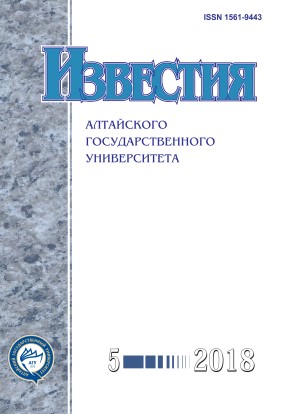The Activity of Protestant Communities in the Altai Territory in the Mid-1970s — 1980s
Abstract
The article is devoted to the study of peculiarities of the Altai Territory Protestant churches’ position in the in the mid-1970s — 1980s. During the period in question, state-confessional relations were modernized, both in the USSR on the whole and in the Altai Territory in particular. The active process of registration of Evangelical Christian Baptist organizations (adherents of the All-Union Council), Mennonite and Lutheran communities took place. The authorities also tried to control the religious organizations (Council of Churches of Evangelical Christian Baptists, Pentecostal Church), who did not agree to legalize their activities, allowing them to hold church services in the same place and at same time. The relation of the state to the religious groups in the region is analyzed in the article. The article also reveals peculiarities of Protestant communities’ position, especially the registration process, economic, demographic changes within the communities and religious education of children. It is concluded that during the analyzed period there has been a change in the state-confessional policy in relation to Protestant organizations; the registration of communities is resumed; there was a revitalization of the Pentecostal, Lutheran and Seventh-day Adventist churches.
Downloads
Metrics
References
Жеребятьева Е.Е. Правовое положение протестантских организаций и атеистическая работа в Алтайском крае (1945-1980-е гг.) // Известия Алтайского гос. ун-та. — 2009. — № 4.
Дашковский П.К., Дворянчикова Н.С. Правовое положение христианских общин в 1953-1964 гг. // Религиозный ландшафт Западной Сибири и сопредельных регионов Центральной Азии: коллективная монография / под ред. П.К. Дашковского. — Барнаул, 2015. — Т. II: XX век.
Дашковский П.К., Зиберт Н.П. Особенности государственной регистрации религиозных объединений в середине 1950-х — начале 1980-х гг. // Религиозный ландшафт Западной Сибири и сопредельных регионов Центральной Азии: коллективная монография / под ред. П.К. Дашковского. — Барнаул, 2015. Т. II: XX век.
Одинцов М.И. Русская православная церковь в XX веке: история, взаимоотношения с государством и обществом. — М., 2002.
Конституция (Основной закон) Союза Советских Социалистических Республик (принята на внеочередной седьмой сессии Верховного Совета СССР девятого созыва 7 октября 1977 г.) . — М., 1977.
Государственный архив Алтайского края. — Ф.Р. 1692. — Оп. 1. — Д. 162.
Дашковский П.К., Дворянчикова Н.С. Положение христианских общин в Алтайском крае в середине 1960-х — середине 1970-х гг. // Религиоведение. — 2017. — №1.
Горбатов А.В. Государство и религиозные организации Сибири в 1940-е —1960-е гг. — Томск, 2008.
Бакаев Ю.Н., Симорот С.Ю. Власть и религия. История отношений (1941-1990 гг.). — Xабаровск, 2006.
Государственный архив Алтайского края (ГААК). — Ф.Р. 1692. — Оп. 1. — Д. 218.
ГААК. — Ф.Р. 1692. — Оп. 1. — Д. 187.
Зайцев Е.В. История Церкви АСД. Заокский, 2008.
ГААК. — Ф.Р. 1692. — Оп. 1. — Д. 210.
Izvestiya of Altai State University is a golden publisher, as we allow self-archiving, but most importantly we are fully transparent about your rights.
Authors may present and discuss their findings ahead of publication: at biological or scientific conferences, on preprint servers, in public databases, and in blogs, wikis, tweets, and other informal communication channels.
Izvestiya of Altai State University allows authors to deposit manuscripts (currently under review or those for intended submission to Izvestiya of Altai State University) in non-commercial, pre-print servers such as ArXiv.
Authors who publish with this journal agree to the following terms:
- Authors retain copyright and grant the journal right of first publication with the work simultaneously licensed under a Creative Commons Attribution License (CC BY 4.0) that allows others to share the work with an acknowledgement of the work's authorship and initial publication in this journal.
- Authors are able to enter into separate, additional contractual arrangements for the non-exclusive distribution of the journal's published version of the work (e.g., post it to an institutional repository or publish it in a book), with an acknowledgement of its initial publication in this journal.
- Authors are permitted and encouraged to post their work online (e.g., in institutional repositories or on their website) prior to and during the submission process, as it can lead to productive exchanges, as well as earlier and greater citation of published work (See The Effect of Open Access).








